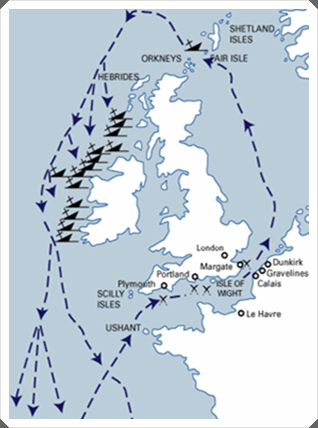
The Girona Shipwreck
The Girona Shipwreck is a fascinating chapter in maritime history. This tragic event, which occurred in 1588, is closely tied to the larger historical context of the Spanish Armada. The sinking of the Girona offers valuable insights into the naval practices of the time, as well as providing a treasure trove of artifacts that shed light on 16th-century life.
The Historical Context of the Girona
The Girona, a magnificent galleass, was part of the formidable Spanish Armada. This fleet was sent by King Philip II of Spain to invade England, aiming to overthrow Queen Elizabeth I. The Armada, however, faced fierce resistance from the English navy, ultimately suffering a devastating defeat. Among the casualties was the ill-fated Girona.
The Spanish Armada and the Girona
The Spanish Armada was a symbol of Spanish naval power and ambition. Its mission was to assert Spain’s dominance in the region and halt the rise of Protestant England. The Armada consisted of over 130 ships, including the mighty Girona. This galleass was a sight to behold, with its towering masts, billowing sails, and fearsome cannons. It was a floating fortress, ready to unleash its firepower upon any enemy that dared to challenge the might of Spain.
The Girona, one of the Armada’s flagship vessels, played a significant role in the endeavor. It was commanded by Captain Francisco de Toledo, a seasoned naval officer known for his bravery and tactical prowess. The ship was manned by a crew of skilled sailors, who had trained relentlessly to ensure the success of their mission. Together, they formed a formidable force, ready to face whatever challenges lay ahead.

The Girona’s Journey and Eventual Demise
After the initial skirmishes with the English navy, the Girona found itself severely damaged and in need of repairs. The decision was made to seek refuge in the treacherous waters near the northern coast of Ireland. The crew navigated through treacherous currents and rocky shores, their hearts filled with hope for a safe haven.
However, fate had a different plan in store for the Girona. As the ship neared the coast, a violent storm descended upon them, unleashing its fury upon the already battered vessel. The waves crashed against the hull, threatening to tear the ship apart. The crew fought valiantly to keep the Girona afloat, but their efforts were in vain.
The storm raged on, mercilessly pounding the ship. The Girona, overwhelmed by the forces of nature, succumbed to the power of the sea. It sank beneath the tumultuous waves, taking the lives of many brave sailors with it. The once proud galleass now lay at the bottom of the ocean, a silent testament to the perils of the sea.
Along with the lives lost, the Girona also carried a valuable cargo. It was rumored to be laden with gold, silver, and other precious treasures. These riches, meant to fund the Spanish war effort, were now lost forever, buried deep within the ocean’s depths. The Girona became a treasure trove for divers and historians, who sought to uncover its secrets and piece together the story of its ill-fated journey.
Today, the Girona serves as a reminder of the ambitions and struggles of the Spanish Armada. It stands as a testament to the bravery and sacrifice of its crew, who ventured into unknown waters in service of their king and country. The story of the Girona continues to captivate the imagination, reminding us of the perils and triumphs of naval warfare in the age of exploration.
The Ship’s Construction and Design
The Girona was a remarkable vessel, renowned for its size, capacity, and unique features. Its construction reflected the advanced shipbuilding techniques of the time, making it a fearsome force on the water.
The construction of the Girona was a testament to the skill and craftsmanship of the shipbuilders. Every detail was meticulously planned and executed to ensure the ship’s strength and durability. The hull was built using the finest oak timbers, carefully selected for their strength and resistance to rot. The planks were expertly joined together using traditional shipbuilding techniques such as mortise and tenon joints, creating a seamless and sturdy structure.
One of the most impressive aspects of the Girona’s construction was its massive keel. Made from a single piece of solid oak, the keel provided the backbone of the ship, giving it stability and strength in even the roughest seas. The keel was carefully shaped and carved to fit the contours of the hull, ensuring a perfect fit and maximum structural integrity.
The Girona’s Size and Capacity
The Girona was an enormous ship, measuring over 50 meters in length and boasting a displacement of thousands of tons. Its size allowed for an extensive cargo hold, capable of accommodating both military supplies and the personal belongings of crew members. This capacity made the Girona an invaluable asset to the Spanish Armada.
Inside the ship, the cargo hold was divided into different compartments to ensure efficient storage and organization. The lower decks were dedicated to storing heavy supplies such as cannons, ammunition, and food provisions. The upper decks housed the crew’s personal belongings, as well as additional supplies and equipment needed for long voyages.
Despite its massive size, the Girona was designed to be easily maneuverable. The ship’s rudder, located at the stern, was carefully balanced and controlled by a system of ropes and pulleys. This allowed the crew to steer the ship with precision, even in the most challenging conditions.
The Unique Features of the Girona
What set the Girona apart from other ships of its era were its design innovations. It was equipped with a distinctive square rigging system, allowing for enhanced maneuverability and speed. The sails were made from the finest canvas, carefully stitched together by skilled sailmakers. The square rigging allowed the Girona to catch the wind from different angles, enabling it to sail efficiently in various weather conditions.
Additionally, the ship incorporated state-of-the-art navigational instruments, highlighting the Spanish commitment to maritime exploration and conquest. The Girona was equipped with a compass, astrolabe, and quadrant, enabling the crew to accurately determine their position at sea. These instruments, combined with the expertise of the ship’s navigators, ensured that the Girona could confidently navigate uncharted waters and reach its intended destinations.
Furthermore, the Girona featured a unique system of watertight compartments. In the event of a breach in the hull, these compartments could be sealed off, preventing water from flooding the entire ship. This innovative design greatly increased the ship’s chances of survival in case of an accident or attack.
Overall, the Girona was a masterpiece of shipbuilding and design. Its size, capacity, and unique features made it a formidable presence on the water, and a symbol of Spanish maritime power during the Age of Exploration.
The Discovery and Excavation of the Girona
For centuries, the Girona lay hidden beneath the ocean’s surface, its existence largely forgotten. It was not until the late 20th century that the ship’s wreckage was stumbled upon, leading to an extensive excavation process.
Initial Discovery and Recognition
The Girona’s discovery was an accidental one, occurring during a routine underwater survey. Archaeologists were astounded to find the remains of a shipwreck of such historical significance. Soon, efforts were launched to accurately identify the wreckage as that of the Girona and to uncover the secrets it held.
The Excavation Process and Challenges
Excavating the Girona proved to be a daunting task. The wreckage was scattered across a wide area, and the ocean’s currents had buried many artifacts deep within the seabed. Nevertheless, a team of dedicated archaeologists meticulously documented and recovered countless relics, piecing together the puzzle of the ship’s final moments.
The Artifacts Recovered from the Girona
The excavation of the Girona yielded a wealth of artifacts that provide invaluable insights into the lives of those aboard and the historical context of the time.
Gold and Jewelry Finds
Among the most remarkable discoveries were various gold and jewelry items, including precious gemstones and intricately crafted pieces. These treasures likely belonged to the ship’s officers and wealthy passengers, offering a glimpse into the opulence of the Spanish court.
Weapons and Armory Unearthed
Another significant aspect of the archaeologists’ findings was the wide array of weapons and military equipment recovered from the wreckage. Swords, muskets, and cannons shed light on the Girona’s role as a warship and the weapons used during the conflict with England.
The Significance of the Girona Shipwreck
The Girona Shipwreck goes beyond being a mere naval tragedy. Its historical significance extends into various aspects of 16th-century life, enriching our understanding of the era.
Insights into 16th Century Maritime Practices
Studying the Girona’s design and equipment provides invaluable insights into the maritime practices of the time. It allows us to grasp the challenges faced by seafarers and the technological advancements that shaped the Age of Exploration.
The Girona’s Impact on Historical Narratives
The discovery and excavation of the Girona have helped reshape historical narratives surrounding the Spanish Armada. By bringing to light the personal belongings and weaponry of the crew, we gain a more nuanced understanding of the human experiences and motivations behind this historical event.
The Girona Shipwreck stands as a poignant reminder of the perils faced by seafarers of the past and the historical richness hidden beneath the ocean’s depths. As we continue to uncover its secrets, we deepen our understanding of the world that once was, honoring the lives and stories of those who sailed aboard this majestic vessel.


1 thought on “The Girona Shipwreck”
Comments are closed.